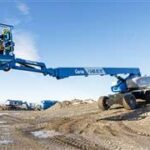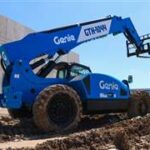What is a Scissor Lift?
A scissor lift is a type of mechanical lift that uses a crisscrossing (scissor-like) mechanism to raise and lower a platform to various heights. Scissor lifts are commonly used in industries like construction, maintenance, warehousing, and other fields that require workers to access elevated areas safely. These lifts are typically powered by electric motors, hydraulics, or a combination of both, depending on the model and the intended application.

Key Features of a Scissor Lift
-
Scissor Mechanism: The most defining feature of a scissor lift is its “scissor” mechanism, which consists of a series of interlocking, crisscrossing supports that expand and contract as the lift raises or lowers. This allows for a relatively compact design that extends vertically with a minimal footprint.
-
Platform: The lift is equipped with a platform or work surface that can support one or more workers and their tools or equipment. These platforms often feature safety rails or guardrails to keep workers secure.
-
Height Adjustability: Scissor lifts are designed to raise workers to heights ranging from a few feet to as high as 50 feet or more, depending on the model. This makes them ideal for accessing areas like ceilings, rooftops, shelves, and high walls.
-
Types of Scissor Lifts:
- Electric Scissor Lifts: These are commonly used indoors because they operate cleanly and quietly, with zero emissions. They’re ideal for environments like warehouses or factories.
- Rough Terrain Scissor Lifts: These are equipped with larger, more rugged tires, making them suitable for outdoor use, particularly on uneven surfaces like construction sites or landscaping projects.
-
Power Sources: Scissor lifts are powered by various means, with the most common being:
- Electric: Typically used for indoor applications, these lifts are powered by batteries and offer silent operation with minimal environmental impact.
- Hydraulic: These lifts use hydraulic fluid to power the lifting mechanism, often found in outdoor, heavy-duty applications.
- Hybrid: Some models combine electric and hydraulic power for enhanced performance in various environments.
Advantages of Scissor Lifts
-
Safety: Scissor lifts provide a stable platform with guardrails, reducing the risk of falls compared to ladders or scaffolding. Additionally, they are equipped with features like emergency stop buttons, tilt sensors, and overload protection for added safety.
-
Ease of Use: These lifts are relatively easy to operate, with simple controls that can raise or lower the platform to the desired height. Many models also have small enough footprints to fit through standard doorways, making them versatile for indoor and outdoor tasks.
-
Versatility: Scissor lifts are highly versatile, able to accommodate a wide range of industries and tasks. They can be used for everything from construction work to window washing, electrical maintenance, painting, and even inventory management in large warehouses.
-
Cost-Efficiency: While scissor lifts may have a higher initial cost compared to ladders or scaffolding, their efficiency and safety benefits can result in cost savings over time, especially in terms of reducing workplace injuries and boosting productivity.
Common Applications
-
Construction and Renovation: Scissor lifts are frequently used to access hard-to-reach areas during construction, painting, and electrical work. Their ability to lift heavy materials and workers simultaneously makes them invaluable on job sites.
-
Warehousing and Inventory Management: In large warehouses, scissor lifts are used for accessing high storage shelves to retrieve items, load goods onto trucks, or perform routine maintenance on facilities.
-
Maintenance Work: Scissor lifts are widely used for tasks like window washing, HVAC system repairs, and electrical maintenance. Their height-adjustability allows workers to easily reach high areas without needing to set up scaffolding or ladders.
-
Film and Photography: In the entertainment industry, scissor lifts are used to elevate cameras, lighting, and crew members to obtain shots or access overhead equipment on set.





